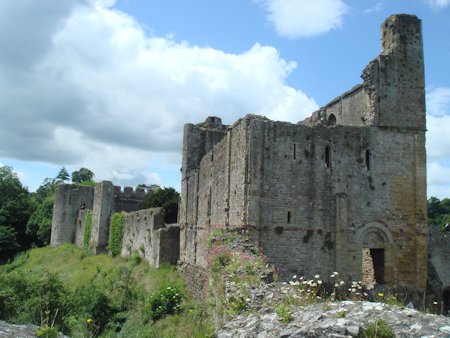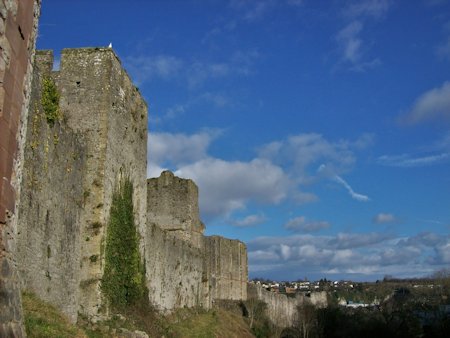
Chepstow Castle
Chepstow Castle is one of Wales’ earliest and most impressive castles. It sits high on cliff guarding a key crossing point of the River Wye and it is probably the oldest stone castle structure in Britain.
Work on the castle began in 1067, during the Norman conquest of England.
William Fitz Osbern had been made Earl of Hereford and given considerable power over that part of western England to defend the border. He started the castle at Chepstow and secured the border by using his castles at Chepstow and Monmouth to conquer Gwent.
William probably didn’t see the keep fully constructed before his death in Flanders in 1071 and it reverted to the Crown in 1075.
In 1115 King Henry I awarded the Marcher lordship to Walter fitz Richard de Clare. The de Clare family later became the Earls of Pembroke.
The Earls of Pembroke held the castle for over a century, but there probably wasn’t much done at the castle until the Earldom’s second creation for William Marshall.
Extension and Fortification
William Marshall and his sons greatly extended the castle. Walter built the wall separating the middle and lower bailey along with its two flanking towers. These two towers are probably the oldest circular mural towers in Wales.
Between them, William’s sons, William, Richard, Gilbert and Walter, built the four baileys and the gateways between them. The powerful twin-towered gatehouse at the east end of the castle was probably constructed by either Gilbert or Walter. The domestic buildings in the Lower Bailey and some of the defensive buildings in the Upper Bailey were also completed around this time.
By 1245 much of Chepstow’s basic layout was settled and it was around this time that the castle passed to the Earls of Norfolk.
Chepstow Castle Layout
Chepstow is laid out on a ribbon of land, with limestone cliffs above the River Wye on its northern side and a valley to the south.
The main gatehouse is on the eastern end of the site. It is guarded by two towers on either side of the gate and Marten’s Tower on the far south-eastern edge of the castle.
The eastern end of the site also has the Lower Bailey, which contains most of the castle’s domestic buildings including the kitchens and the hall. It is separated by a cross-wall from the Middle Bailey. The Middle Bailey has the Norman Great Tower on its western wall with a gallery leading through to the Upper Bailey. The western bailey has a small oblong tower and a barbican.
Roger Bigod, 5th Earl of Norfolk inherited Chepstow in 1245. Unusually, the accounts from his construction work survive, so historians can tell which parts of the castle he constructed.
Roger’s additions were mainly in the eastern end of the site. He built a new suite of domestic apartments and the substantial Marten’s Tower and he added to the height of the keep.
The castle reverted to the Crown on Roger’s death. In October 1326 Chepstow was briefly visited by King Edward II just before his aborted attempt to escape to Ireland.
Chepstow had a sizeable garrison during Owain Glyndwr’s uprising. Glyndwr’s forces never attempted to take it however.
Later Years
By the 15th Century Chepstow had come in to the possession of the Earls of Worcester. Sir Charles Somerset, 1st Earl of Worcester, remodelled the domestic buildings and made it a comfortable place to live, though the Earls’ seat remained at nearby Raglan Castle.
Chepstow was on the Royalist side and was besieged twice during the English Civil War. The garrison didn’t put up much of a fight against the Parliamentarians in 1645 and it was surrendered quite quickly. In 1648 Cromwell himself commenced the siege. It only surrendered after a long bombardment and part of the southern curtain wall collapsed.
After the war the southern wall was repaired and reinforced against cannon fire. Thereafter the castle served as a prison until it was abandoned in the late 1680s.
In the 18th Century it became part of the Wye Tour – a pleasure boat trip for tourists. By the 19th Century it had become a venue not only for tourists, but for fetes, shows and pageants which were held in its courtyard.
In 1953 it passed in to the care of the Ministry of Works. Its successor, Cadw, still owns and maintains the castle today.
Chepstow Castle is open to the public. There are information boards to guide you around the site and you can get up on to the battlements and in to Marten’s tower. Facilities available include car parking and toilets, a gift shop and an exhibition on the castle’s history.
Disabled access is good with disabled car parking, toilets and a mobility scooter available.
Chepstow has been used as a location for a number of film productions, including “Ivanhoe” in 1913, part of Sepultura’s fifth album in 1993 and most recently Doctor Who’s 50th anniversary in 2013.
Status: Heritage Site / Visitor Attraction
Owner: Cadw
Tel: +44 (0) 1291 624 065
Website: http://cadw.gov.wales/
Opening Times: March to June Daily 9.30am to 5pm, July & August Daily 9.30am to 6pm, September & October Daily 9.30am to 5pm, November to February Daily 10am (11am Sundays) to 4pm


The north wall and Great Tower at Chepstow

The reinforced southern walls